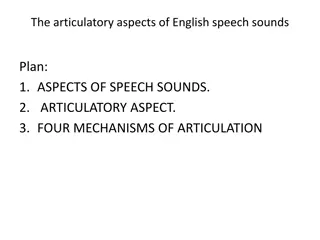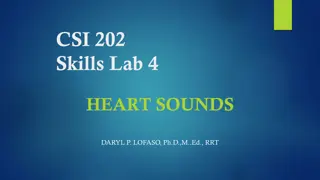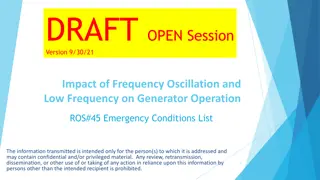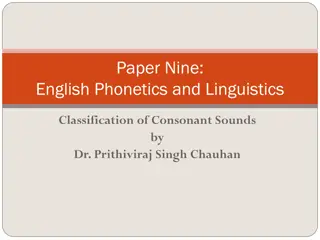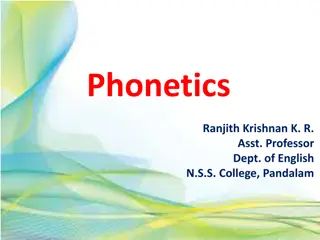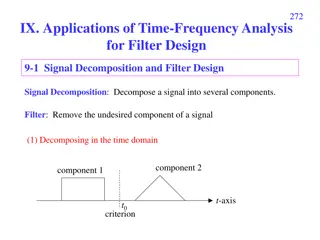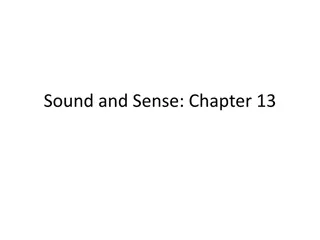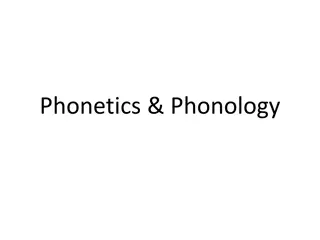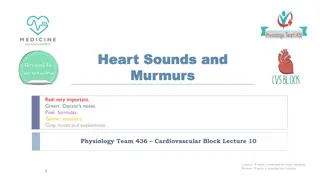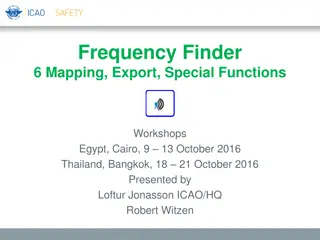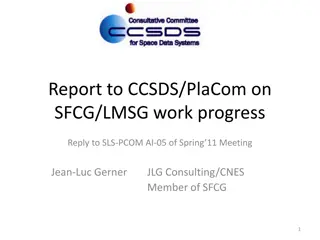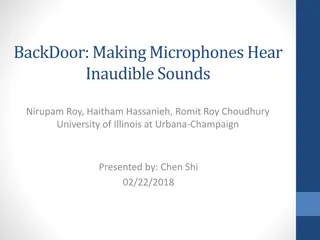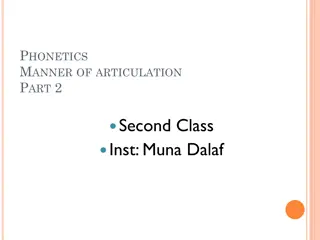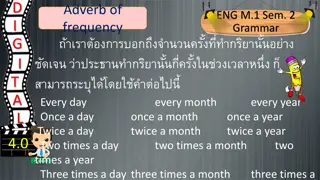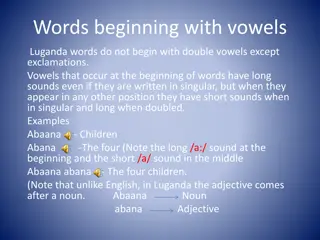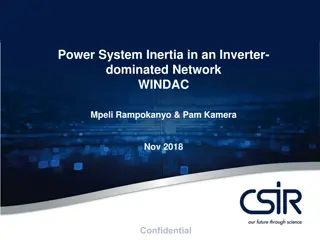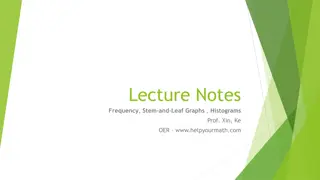Understanding Articulatory Aspects of English Speech Sounds
Speech sounds are integral to language, with articulatory, acoustic, auditory, and functional aspects. Articulation involves mechanisms like the power, vibrator, resonator, and obstruction mechanisms. The power mechanism includes the respiratory system, while the vibrator mechanism operates through
10 views • 10 slides
Understanding Frequency Weighting in Noise Pollution Measurement
Frequency weighting is essential in noise pollution measurement to reflect how the human ear perceives noise. The A, C, and Z weightings are commonly used to represent different frequency responses. A-weighting covers the audible frequencies where the human ear is most sensitive, while C-weighting i
2 views • 7 slides
Engaging Animal Sounds Lesson for Grade 1 English Class
Explore the world of animal sounds with an interactive lesson designed for Grade 1 English students. The lesson includes activities to help students recognize animals and their sounds, fostering engagement and learning in a fun way. From identifying animals to mimicking their sounds, this lesson pro
7 views • 18 slides
Load Frequency Control in Power Systems
Electric power systems require Load Frequency Control (LFC) to maintain a uniform frequency, distribute load among generators, and manage tie-line interchange schedules. LFC detects frequency changes, generates real power commands to adjust torque, and ensures stability within specified limits. Reas
8 views • 38 slides
Introduction to Syllable Types
Delve into the world of phonetics with this informative content explaining vowel sounds, consonant sounds, and the concept of syllables. Discover the differences between short and long vowel sounds, voiced and unvoiced consonants, and how syllable types can aid in pronunciation. Engage in interactiv
2 views • 31 slides
Lessons on Short A, I, O Sounds in an Advanced Level Setting
Dive into advanced lessons focusing on the Short A, I, and O vowel sounds. Explore various slides and exercises that will enhance your pronunciation and understanding of these sounds to improve your overall language skills.
3 views • 108 slides
Understanding Language: An Overview of Linguistics
Linguistics is the scientific study of language, a complex system of sounds, words, and patterns that humans use to communicate thoughts and feelings. Language consists of phonology (sounds), morphology (words), syntax (sentences), semantics (meaning), and pragmatics (contextual meaning). Different
0 views • 42 slides
Understanding Heart Sounds and Murmurs in Cardiology
Explore the intricacies of heart sounds and murmurs in cardiology, including their locations, characteristics, timing, and associated factors. Learn about the pitch, loudness, and types of murmurs, and understand the distinctions between systolic and diastolic murmurs. Enhance your knowledge of card
0 views • 14 slides
Year 1 Phonics - Learning Sounds and Words
The Year 1 Phonics program for the week commencing 18.1.21 focuses on learning Phase 5 sounds, including the 'aw', 'wh', and 'ph' sounds. Students practice reading and writing words with these sounds, play interactive games, and form sentences integrating the learned sounds. Engaging activities like
2 views • 22 slides
Impact of Frequency Oscillation on Generator Operation: Emergency Conditions Analysis
Analyzing the impact of frequency oscillation and low frequency on generator operation during emergency conditions. Investigating how lower frequency affects units' ability to respond to deviations, system stability, and load shedding processes. Examining system responses during Energy Emergency Ale
0 views • 31 slides
Understanding English Consonant Sounds: A Detailed Guide
This guide delves into the English phonetics and linguistics classification of consonant sounds, emphasizing factors such as place of articulation and manner of articulation. It covers various types of consonant sounds, from bilabial and labio-dental to alveolar, post-alveolar, palatal, velar, and g
1 views • 11 slides
Phase 1 Phonics: Developing Early Listening and Speaking Skills
Phase 1 Phonics, the initial stage of Letters and Sounds, focuses on enhancing children's speaking and listening abilities to prepare them for phonics work in Phase 2. This phase emphasizes tuning in to sounds, listening and remembering sounds, and talking about sounds through various activities des
3 views • 17 slides
Understanding Transmission Operator Obligations in Under-Frequency Load Shedding
ERCOT Compliance ensures that Transmission System Operators (TSOs) and Distribution System Operators (DSOs) have automatic under-frequency load shedding circuits in place to provide load relief during under-frequency events. The TSOs are required to shed a specific percentage of their connected load
0 views • 6 slides
Coordinated AP Time/Frequency Sharing in IEEE 802.11be
The document discusses the concept of Coordinated AP (CAP) Time/Frequency Sharing within a Transmit Opportunity (TXOP) in the IEEE 802.11be standard. It explains the procedures of Frequency and Time resource sharing, highlighting the benefits such as latency improvement and throughput fairness. Deta
0 views • 16 slides
Understanding Phonetics: Sounds, Symbols, and Classification
Explore the world of phonetics with a focus on speech sounds, the International Phonetic Alphabet (IPA), organs of speech, and different types of phonetics including acoustic, auditory, and articulatory phonetics. Discover the unique characteristics of English sounds, vowels (monophthongs and diphth
0 views • 13 slides
Analysis of Low-Frequency Response in BJT and FET Amplifiers
This analysis delves into the low-frequency response of BJT and FET amplifiers, examining the impact of various components such as resistors and capacitors on the cutoff frequencies. Detailed examples illustrate the calculation process for determining these frequencies based on specific parameters.
0 views • 18 slides
Insights from ET-ISB Workshop on Low-Frequency Noise and GWADW 2021
The ET Instrument Science Board held a workshop focusing on addressing key challenges related to low-frequency noise in gravitational wave detectors. Experts discussed topics such as mirror temperature, dealing with low-frequency noise realities, and facility limits. The workshop highlighted the sig
0 views • 13 slides
Applications of Time-Frequency Analysis for Filter Design
Signal decomposition and filter design techniques are explored using time-frequency analysis. Signals can be decomposed in both time and frequency domains to extract desired components or remove noise. Various transform methods like the Fourier transform and fractional Fourier transform are employed
1 views • 35 slides
Exploring Norman MacCaig's Poem "Sounds of the Day" in Kelso High School English Department
Delve into Norman MacCaig's poem "Sounds of the Day" through the lens of the Kelso High School English Department. Uncover the themes, poetic techniques, and structure of the poem as it guides readers through vivid natural sounds to a poignant reflection on parting. Understand the form, organization
0 views • 25 slides
Exploring Sound Associations in Language
Delve into the fascinating world of onomatopoeic words, phonetic intensives, and associations between sound and meaning in language. Discover how words like "hiss," "snap," and "bang" mimic their sounds, and how sounds like "fl-" relate to moving light. Explore the connections between sounds and the
0 views • 15 slides
ICAO Handbook on Radio Frequency Spectrum Requirements for Civil Aviation Workshops
This handbook provides insights into spectrum requirements for civil aviation workshops conducted in Egypt and Thailand in October 2016. It covers spectrum strategy, frequency management, spectrum overview for aviation, and frequency assignment planning to support the application of SARPs in Annex 1
0 views • 10 slides
High Frequency Market Microstructure - A Comprehensive Overview
Delve into the intricate world of high-frequency market microstructure with a detailed exploration of how traders operate, market structures, regulatory influences, and the evolution of trading platforms. Uncover the birth of High-Frequency Trading (HFT), the strategies employed by high-frequency tr
0 views • 12 slides
Exploring the World of Phonetics and Phonology
Delve into the fascinating realms of phonetics and phonology, where the science of human speech sounds is decoded. From the production to perception of sounds, this field encompasses articulatory phonetics, auditory phonetics, and acoustics phonetics. Discover how speech sounds are intricately forme
0 views • 25 slides
Understanding Two-Way Frequency Tables in Data Analysis
Explore the concept of representing and interpreting data in two variables using two-way frequency tables. Learn about joint frequency, marginal frequency, and conditional relative frequency through a practical example involving gender and nail services. Discover how to target specific audiences bas
0 views • 15 slides
Understanding Heart Sounds and Murmurs in Cardiovascular Physiology
This detailed lecture covers the basics of normal and abnormal heart sounds, stethoscope placement, cardiac auscultation, and the physiological significance of heart murmurs. It explains the causes, descriptions, and grading of abnormal heart sounds, along with specific conditions like aortic stenos
0 views • 26 slides
Understanding High-Frequency Market Microstructure and Trading Strategies
Exploring the intricate world of high-frequency trading (HFT) and its implications on market microstructure. Delve into how HFT influences traders' strategies, market gaps, technological advancements, and latency management. Discover the evolution of trading behaviors and the impact of regulatory po
0 views • 14 slides
Frequency Finder 6 Mapping Workshops Overview
Explore the Frequency Finder 6 Mapping, Export, and Special Functions workshops held in Egypt and Thailand in October 2016. The workshops cover topics such as mapping station coverage, exporting data to different formats, accessing historical frequency assignment records, and ensuring data integrity
0 views • 7 slides
Engaging Phonics and High Frequency Words Activities for Children
Explore a range of interactive activities to reinforce phonics sounds, tricky words, and high frequency word recognition for children in an engaging manner. From phonics sounds revision to playing Tricky Words Snowballs, these activities aim to enhance language skills effectively. Additionally, reca
0 views • 15 slides
Understanding Lung Sounds and Auscultation Techniques
Exploring the world of chest auscultation with Dr. Mohammed Sami, this guide provides insights into how to listen to lung sounds, where to listen, what to listen for, and the use of a stethoscope. Learn about different lung areas, sound characteristics, airflow patterns, and the mechanics behind bre
0 views • 34 slides
Progress Report on Lunar-Mars Spectrum Group Work within SFCG
The Lunar-Mars Spectrum Group (LMSG) met to review important input documents related to lunar communications, including compatibility studies, frequency considerations, and frequency assignment guidelines. The group identified the need for further work to refine proposed reports and agreed on new ac
0 views • 17 slides
IEEE 802.11-18-1269-00-00az Clock Synchronization Investigation
In July 2018, a document was presented by Feng Jiang et al. from Intel Corporation focusing on clock synchronization between ISTA and RSTA in IEEE 802.11-18-1269-00-00az standard. The document delves into the impact of sampling clock errors on range estimation, carrier frequency synchronization in 1
0 views • 10 slides
Unlocking Microphones to Hear Inaudible Sounds Using BackDoor System
Researchers from the University of Illinois at Urbana-Champaign have developed the BackDoor system, which allows regular microphones to record high-frequency inaudible sounds by leveraging hardware non-linearity. The system utilizes a linear amplifier with non-linear behavior to capture signals at f
0 views • 17 slides
Sounds of Second Class Phonetic Manner of Articulation
Fricative sounds, produced by narrowing the air passage, create hissing sounds like /f/, /v/, /s/, /z/, and more. Affricates start as stops and end as fricatives, like in "chin" and "chest." Explore examples of sounds and articulation processes in English phonetics.
0 views • 6 slides
Overview of Fricative Sounds in English Pronunciation
This content discusses various fricative sounds in English pronunciation, focusing on the articulation of sounds like /s/ and /z/. It covers the positioning of the soft palate, tongue, teeth, and lips while producing these sounds, providing examples like "thin," "think," "free," and more. The conten
0 views • 11 slides
Understanding Adverbs of Frequency in English Language Studies
Explore the usage of adverbs of frequency such as "every day," "twice a month," and "once a week" in English grammar through exercises and examples. Enhance your understanding of how to construct sentences using present simple tense to describe regular activities. Practice placing adverbs in sentenc
0 views • 53 slides
Year 1 Phonics: Week Commencing 11.1.21
This week's Year 1 Phonics lesson focuses on learning Phase 5 Sounds, with a special emphasis on sounds like 'oy', 'ir', and 'ue'. Students are introduced to words related to these sounds and engage in activities such as reading, writing, drawing, and sorting real and silly words. Interactive links
0 views • 18 slides
Learning Luganda: Vowel Sounds and Practice Song
Explore the rules of Luganda vowel sounds in words, distinguishing between short and long sounds at the beginning or within words. Practice these concepts through a fun song teaching animal sounds and scenarios. Enhance your understanding of Luganda pronunciation with this engaging lesson.
0 views • 4 slides
Understanding Power System Inertia in Inverter-Dominated Networks
This study explores the impact of high levels of instantaneous inverter-based renewable energy penetration on power system inertia. It delves into fundamental concepts of energy balance, frequency control, load/frequency characteristics, and the importance of system inertia in maintaining grid stabi
0 views • 20 slides
Understanding Frequency, Stem-and-Leaf Graphs, and Histograms in Data Analysis
Frequency, relative frequency, and cumulative relative frequency are explained with examples. Stem-and-leaf graphs help in organizing small data sets, while histograms display data with continuous variables. An example with heights of male soccer players demonstrates constructing histograms. Calcula
0 views • 11 slides
Effective Regulation of Active Power in Renewable Energy Sources
The balance between generation and load is crucial in power systems operation. Various control levels ensure this balance, from frequency control to power station planning. DER units may lack control means, but specific configurations allow for frequency and voltage control. Performance indicators a
0 views • 51 slides
